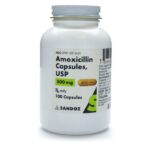Amoxicillin Clavulansyre: Uses, Dosage, Side Effects, Interactions

Amoxicillin Clavulansyre is a Danish combination medication containing amoxicillin and clavulanic acid, used to treat certain infections caused by bacteria, including infections of the ears, lungs, sinus, skin, and urinary tract. Amoxicillin is in a class of medications called penicillin-like antibiotics. It works by stopping the growth of bacteria. Clavulanic acid is in a class of medications called beta-lactamase inhibitors. It works by preventing bacteria from destroying amoxicillin.
Amoxicillin Clavulansyre also is used sometimes to treat certain sexually transmitted diseases (STD). Talk to your doctor about the possible risks of using this medication for your condition. However, this medication will not work for colds, flu, or other viral infections. Using antibiotics when they are not needed increases your risk of getting an infection later that resists antibiotic treatment. Amoxicillin Clavulansyre is manufactured by Aurobindo.
How does Amoxicillin Clavulansyre work?
The amoxicillin part of Amoxicillin Clavulansyre works by interfering with the ability of bacteria to form cell walls. It allows holes to appear in the bacterial cell walls and this kills the bacteria causing the infection.
Some types of bacteria have become resistant to penicillin-type antibiotics, because they have developed the ability to produce defensive chemicals called beta-lactamases that stop the antibiotics from working. The clavulanic acid part of Amoxicillin Clavulansyre is a beta-lactamase inhibitor. It stops bacteria from inactivating amoxicillin, so it increases the range of bacteria that amoxicillin can kill.
How do you take Amoxicillin Clavulansyre and how often?
The dose of Amoxicillin Clavulansyre that’s prescribed and how long you need to take it depends on what infection is being treated, age, weight, and kidney function. Always follow the instructions given by your doctor. These will be printed on the label that your pharmacist has put on the packet of medicine.
• The usual dose of Amoxicillin Clavulansyre is 1 tablet (either 375mg or 625mg) taken 3 times a day. But follow the instructions given by your doctor. Space the doses evenly over the day.
• Amoxicillin Clavulansyre can be taken either with or without food, on a full or empty stomach. If you find it upsets your stomach, taking it with food may help.
• Try to drink plenty of fluids while you’re taking Amoxicillin Clavulansyre.
• Amoxicillin Clavulansyre tablets should be swallowed whole with a drink.
• Bottles of suspension should be shaken before measuring out a dose. Only use the measuring spoon or oral syringe provided with the suspension. Don’t use a regular teaspoon or tablespoon to give the medicine, as this will not give an accurate dose.
The dose may be lower for children. The doctor will use your child’s weight to work out the right dose for them.
What if I miss a dose?
If you miss a dose, take it as soon as you remember. If it is near the time of the next dose, skip the missed dose and resume your usual dosing schedule. Do not double the dose to catch up.
Can You overdose on Amoxicillin Clavulansyre?
Yes, if overdose is suspected, contact your local poison control center or emergency room immediately. US residents can call the US national poison hotline at 1-800-222-1222. Canadian residents should call their local poison control center directly. Symptoms of Amoxicillin Clavulansyre overdose may include severe stomach/abdominal pain, severe vomiting, persistent diarrhea, a severe decrease in the amount of urine, or seizures.
What are the possible side effects of Amoxicillin Clavulansyre?
Get emergency medical help if you have signs of an allergic reaction (hives, difficult breathing, swelling in your face or throat) or a severe skin reaction (fever, sore throat, burning eyes, skin pain, red or purple skin rash with blistering and peeling).
Call your doctor at once if you have:
• severe stomach pain, diarrhea that is watery or bloody (even if it occurs months after your last dose);
• pale or yellowed skin, dark colored urine, fever, confusion or weakness;
• loss of appetite, upper stomach pain;
• little or no urination; or
• easy bruising or bleeding.
Common side effects may include:
• nausea, vomiting; diarrhea;
• rash, itching;
• vaginal itching or discharge; or
• diaper rash.
This is not a complete list of side effects and others may occur. Call your doctor for medical advice about side effects. You may report side effects to FDA at 1-800-FDA-1088.
What drugs can interact with Amoxicillin Clavulansyre?
Tell your doctor about all your other medicines, especially:
• allopurinol;
• probenecid; or
• a blood thinner – warfarin, Coumadin, Jantoven.
This list is not complete. Other drugs may interact with Amoxicillin Clavulansyre, including prescription and over-the-counter medicines, vitamins, and herbal products. Not all possible drug interactions are listed here.





